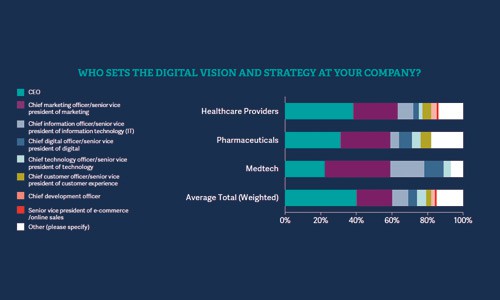
From big data and social media to wearable tech and the Internet of Things, the digital revolution is transforming how customers and patients interact with healthcare in the medical technology (medtech) industry.
Compared with the healthcare sector as a whole, Russell Reynolds Associates’ (RRA) research shows that, except for a handful of early innovators, the medtech industry is less convinced that it is in the midst of a digital transformation. A survey of more than 2,000 executives across multiple industries reveals that only 33% of medtech companies foresee digital technologies as a major disruptor of their business over the next 12 months, compared to 57% of businesses across other industries.
To further understand how medtech compares with other sectors, RRA analysed the digital leadership of healthcare companies in the Fortune 500 and FT 500.
Our study finds that, compared to businesses in other industries, medtech companies have made less progress in establishing and executing a digital strategy that is supported by the organisation’s structure, led by a digital owner and one that prioritises hiring talent with the necessary digital expertise.
Strategy and structure
According to our cross-industry survey findings, nearly three-quarters of medtech companies have a digital strategy. However, this is a relatively low proportion compared with many other sectors, including retail banking and consumer financial services (89%), pharmaceuticals (81%) and consumer-packaged goods (78%). Furthermore, only 19% of medtech businesses say their organisation is structured in the right way to realise the new opportunities that digital presents. Even more surprisingly, a third don’t know if their organisation is structured to support digital innovation, suggesting that even if a strategy exists, it is rarely being communicated and/or implemented effectively.
Digital leaders of the future are innovative, disruptive [and] bold in leadership
Digital ownership
Medtech diverges from the executive ownership trends seen across other industries, with digital most often led by the head of marketing (37%) or the chief executive officer (CEO) (22%) and, to a lesser extent, the chief information officer. Our research also reveals that twice as many CEOs in other industries take ownership of digital vision and strategy compared with the medtech sector. Perceptions within an organisation about who is driving digital can be a key factor in successful transformation, and the ownership of digital transformation needs to start with the CEO and senior C-suite executives to ensure it effectively cascades down to other levels within an organisation.
CEOs need to drive and support their organisation’s digital strategy and ensure buy-in and engagement from the top. Experience suggests that the key to securing a competitive advantage is to embrace digital as a solution from within the business, with effective governance at the board level and good internal communication critical to its success. Digital leadership from the board of directors sends out a clear signal to the rest of the business and since 2013, RRA has seen the number of digital board director appointments more than double across all sectors globally.
Although executive ownership of digital generally lies with the CEO, according to our survey, only half of all participants are confident that they currently have the right talent to define and implement their digital strategy across all industries, including medtech.
Necessary expertise
Digital leaders of the future are innovative, disruptive, bold in leadership, socially adept and determined, and they demonstrate these qualities to an even greater extent than other executives.
Within healthcare, a high proportion of external and out-of-industry digital leader appointments suggest that talent with the necessary skill set to drive digital transformation across an organisation, including at board and senior executive level, is currently scarce within the industry. This is especially true in the medtech sector, with 80% of digital innovation leaders coming from external appointments, half of which were hired from outside the industry.
Across healthcare as a whole, 40% of digital leaders are out-of-industry hires, with the majority coming from the consulting, media and retail sectors. Whether hired from inside or outside the healthcare industry, digital innovation leaders generally have a functional background in commercial, IT/healthcare IT or strategy.
The medtech sector’s future CEOs and senior digital leaders will have to think across the entire healthcare value chain from payer to patient in order to maximise the potential of digital. Although the right leadership is only one part of the picture, it is essential that medtech companies understand the circumstances that have been important in leading digital transformation in other industries.





